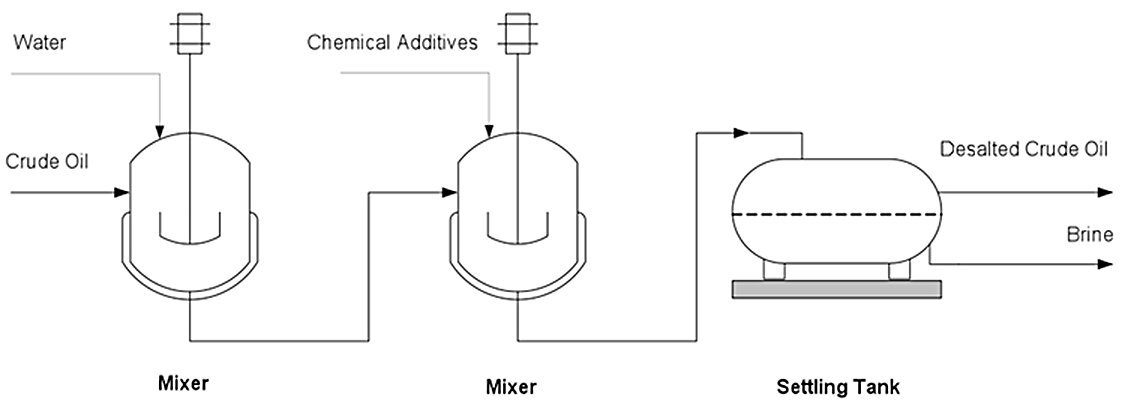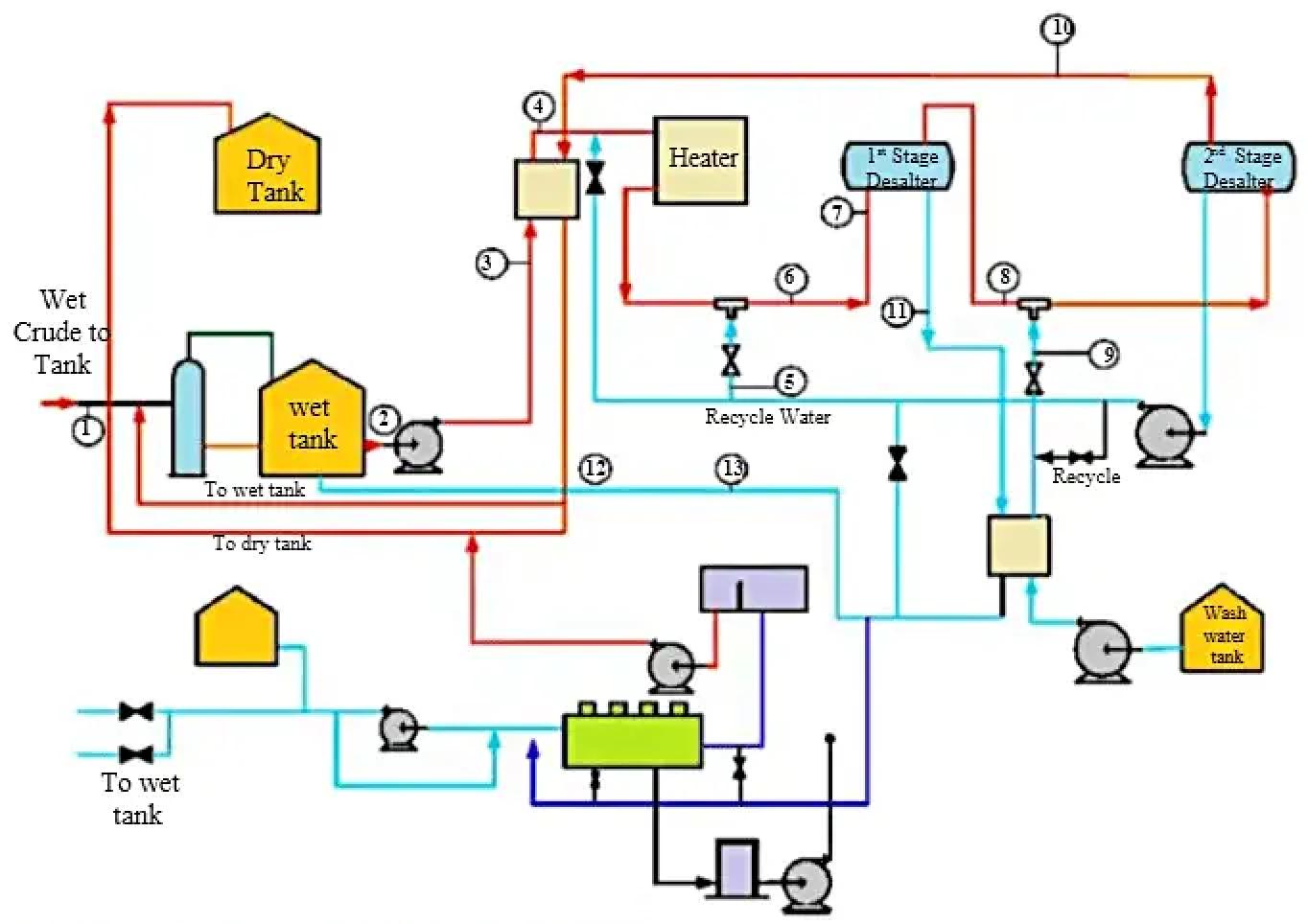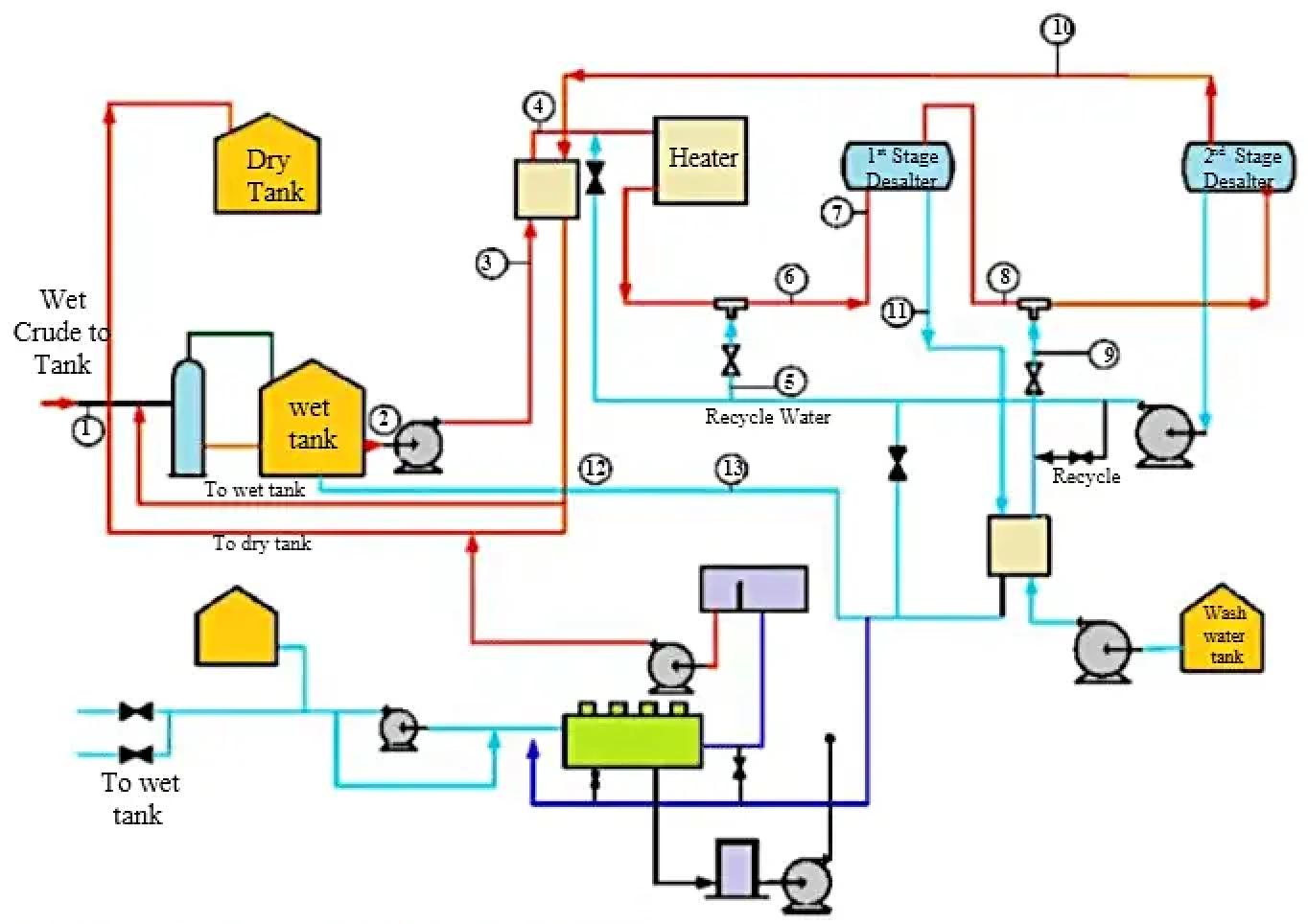Purpose of crude oil dehydration and desalting
Crude oil received after transportation includes many types of salt traps in small droplets of water staggered all locations of the volume. These droplets are so small that self-extraction and settling are not possible. In general, there are three types of oleophobic Impurities found in crude oil:
- Salt: Mainly chlorides and Sulphates of Sodium (Na), Potassium (K), Calcium (Ca), and Magnesium (Mg).
- Sediments: Such as silt, sands, Mud, Iron oxide, and Sulphides.
- Water: Present as soluble, emulsified, and finely dispersed form.
If crude oil is left untreated before processing, salt present in crude oil can cause many types of operating failure and maintenance problems. Crude oil Dehydration and desalting is an important part of the refinery that helps to clean crude oil in its initial processing stage:
- Crude oil dehydration is the process of removing the water present in crude oil.
- Desalting of crude oil means the removal of the dissolved salt in the crude oil and increasing the grade of the crude oil.
- Since salt is dissolved in the water phase, dehydration is also effectively desalting.
The crude oil desalting and dehydration procedure is carried out in three steps:
- Destabilization of the emulsion
- Coalescence of small drops into large drops
- Settling out of large drops and separation of the two phases.
By this process, a considerable percentage of suspended solids (sand, clay, or soil particles, or even particles product from corrosion of pipelines and other upstream equipments) are removed.
Methods of Dehydration and Desalting of Crude Oil
Water and oil are separated by virtue of their different densities; gravity is the driving force. Large density differences between oil (ρo) and water (ρw) and low oil viscosities are favorable for easy separation and therefore light crudes separate faster than heavy crudes. An increase in temperature causes a reduction in viscosity, therefore the application of heat can be used to accelerate the separation of heavy crude.
The settling rate depends on the square of the droplet diameter. Drop-to-drop coalescence increases droplet diameter and for this reason, coalescence is a key factor in successful dehydration. Unfortunately, however, many oilfield dispersions resist coalescence and are known as ‘stable dispersions’ or ‘stable emulsions. Oil and water mixtures would be highly unstable were it not for naturally occurring surface-active agents (surfactants) and finely divided particles that are absorbed in oil/water interfaces to form rigid films that resist coalescence. In this way, surfactants stabilize fine droplets which then accumulate to form emulsions. Water in oil emulsions is known as ‘normal’; most oilfield emulsions are in this category. Oil in water emulsions is termed ‘reverse’.
There are three main methodes employed for destabilisation of emulsions of crude oil and water:
- Mechanical: heated crude mixed with wash water is left in a large vessel for settling down of water droplets by gravity. This is not a very effective method as it takes a lot of time to allow for water to settle down.
- Chemical: surfactant or demulsifiers are mixed with wash water to expedite the process of water settling down. This method also works according to gravity settling technique but because of the addition of demulsifiers demixing is faster but still not very effective.
A simplified chemical desalting process is shown in the following diagram:

- Electrical Desalting: the method works according to the electrostatic field principle by virtue of which an attractive force is generated because of the application of high voltage. The electrostatic field induces polarization on the water droplets, causing them to coalesce and grow large enough to settle out of the oil under gravity. The separated water is then removed from the system, leaving behind a desalted and dehydrated crude oil.
The following picture shows a general process flow diagram for one- and two-step desalting processses:

Dehydration and Desalting Equipment
Various types of vessels are employed for performing crude oil dehydration and desalting. Equipment guidelines are disclosed in the following table:
| Equipment |
Application |
Comments |
| 1. Free water knockout (FWKO) type separator |
For high water cut crudes where the bulk of the water separates quickly |
Final crude polishing to export quality can be carried out using other methods |
| 2. Dehydration type separator |
for low water crudes where dehydration to about 1-5% water is required |
Usually located downstream of FWKO separator(s) in offshore applications |
| 3. Heater treater |
Considered for dehydration of difficult emulsions or very viscous crudes |
Choice based on economic arguments. Can be operated at temperature > 100°C |
| 4. Wash tank |
General purpose. Particularly useful with higher water cut crudes |
Careful design of internals
required to avoid channelling |
| 5. Concentric wash tank |
Particularly useful for heavy, high water cut crudes |
More expensive conventional design and more difficult to operate |
| 6. Settling tank |
General purpose. Use especially where plenty of tankage is available |
Not a good choice for high water cut crudes |
| 7. Electrostatic coalescer |
Considered when deep dehydration is required (to about 0.5% water) |
More sophisticated, hence more potential problems. Shortcircuiting problems. |
Typical Plant Layout
Depending on the desired salt content in the desalted crude oil, a one- or two-step desalting process could be applied. For refining purposes, a salt concentration of maximum 1, 5 PTB (pound of salt measured as NaCl per thousand barrels) is desired.
In a one-step configuration 90% of salt removal can be achieved. For higher salt removal percentages, a two-step configuration should be required. As far as the last process configuration is concerned two demulsifier injection points are used, both before the mixing valve in the first and second step. In addition, freshwater is fed to the second stage, and effluent water from this stage is recycled to the first one. With this configuration, a 99% salt removal could be achieved.
A typical process flow scheme is illustrated as it follows:

List of components (units):
- Wet crude flow to wet tank.
- Demulsifier / Chemical injection.
- Crude flow to the heat exchanger.
- Flow to the heater.
- Wash water recycled from 2nd stage vessel.
- Flow to 1st stage desalting mixing valve.
- Mixed fluid to 1st stage vessel.
- Flow to 2nd stage desalting mixing valve.
- Freshwater from the oil-water heat exchanger originated from the wash water tank.
- Treated crude flow.
- Effluent water from 1st stage Desalter vessel to water treatment plant and/or disposal pit.
- BS&W Analyzer – A signal to diverting Valve.
- Formation (free) water settled down at the bottom of the wet tank, to the water treatment plant and/or disposal pit
References
Adapted from:
- What is Piping Blog. Anup Kumar Dey. DeSalting and Dehydration of Crude Oil
- All About Piping Blog. Vaibhav Raj. Crude Oil desalter: Purpose, Working, Types, Parts, variables
- J. Pereira et al.. 2015. Crude Oil Desalting Process. Advances in Petrochemicals Chapter 4, IntechOpen Publisher
- S. Eser and M. R. Riazi. Apri 29, 2013. ASTM MLN5820131211705 - Crude Oil Refining Processes. In: Petroleum Refining and Natural Gas Processing (2013), pp. 101-125. DOI: 10.1520/MNL5820131211705. ISBN-EB: 978-0-8031-8681-1. ISBN-13: 978-0-8031-7022-3.













